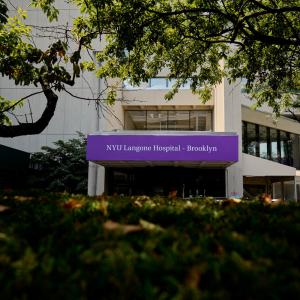By swabbing babies born by cesarean delivery, or C-section, with their mothers’ birth fluid, researchers partially restored the mix of bacteria that coat a newborn’s body when delivered vaginally. This is the finding of a pilot study co-led by researchers from NYU Langone Medical Center and published online on February 1 in Nature Medicine.
The study revolves around the microbiome, the set of bacterial species that live on and in human skin, mouths, and guts. Such microbes evolved over millions of years to play roles in human digestion, metabolism, and immunity.
C-sections interrupt the “education” provided by the microbes that come with vaginal birth, which help newly formed immune systems tell the difference between helpful and disease-causing bacteria, say the study authors. Past studies have shown that infants delivered vaginally harbor bacterial communities resembling those of the mother’s vagina, while the microbes of C-section infants resemble those on the mother’s skin.
As C-sections, antibiotic use during pregnancy, and dependence on baby formula have increasingly disrupted the development of natural microbiomes in recent decades, rates of asthma, autoimmune diseases, and obesity have more than doubled. Many studies have now shown associations between these trends, but only a few experiments in mice have found that microbial differences directly increase risk for these diseases.
“Our study is the first to demonstrate that partial microbiome restoration just after birth is possible in babies born by C-section,” says lead study author and microbiologist Maria Dominguez-Bello, PhD. “With a third of U.S. babies now born by C-section, twice the number as is medically necessary, the question of whether a baby’s founding microbiome affects its future disease risk has become more urgent,” says Dominguez-Bello, an associate professor in the Department of Medicine at NYU Langone.
The study was conducted within the Division of Translational Medicine, in the Department of Medicine at NYU School of Medicine, and in partnership several researchers at other institutions, including study co-leader Jose Clemente, PhD, at the Icahn School of Medicine at Mount Sinai.
Restored Microbiomes Closer to Natural Childbirth
In the new study, the researchers found that infants delivered by C-section and exposed to maternal vaginal fluids had microbiomes more like babies born vaginally over the first 30 days of life than like C-section infants not exposed. Interestingly, samples taken from vaginally delivered infants and those restored by swabbing had higher numbers soon after birth of Lactobacillus and Bacteroides, species shown by past studies to train the infant’s immune system to recognize and not attack helpful bacteria (immune tolerance). Statistical analyses show clearly that the numbers of these two bacterial groups are much more similar between babies born vaginally and those restored by swabbing than those born by C-section. Larger studies will be needed, however, to draw conclusions about the exact degree of restoration that can be achieved.
To restore the baby’s microbiome in C-section newborns, researchers incubated sterile gauze in the mother’s vagina during the hour before the C-section, and used it to swab the baby’s mouth and body within two minutes of birth. Vaginal birth in mammals leads to a massive exposure of the baby to maternal birth canal microbes.
In the newly published study, the research team collected samples from 18 infants and their mothers, including seven born vaginally and 11 delivered by scheduled C-section, four of which were exposed to vaginal fluids. While the number of babies in this pilot study was small, the team collected more than 1500 samples from the infants and mothers, and then used state-of-the-art genomic and statistical techniques to analyze more than 6.5 million pieces of bacterial DNA.
VIDEO: Dr. Maria Dominguez-Bello explains how swabbing babies born by C-section with their mothers' birth fluid restored a more natural bacterial mix to their microbiome.
In every bacterial cell, the blueprint for the organism is encoded in DNA sequences, which in turn are comprised of nucleotides. These “letters” make up the code containing genetic instructions, and past studies had already matched the sequences of a key DNA snippet to all known bacterial species. Combining their sample sequences and available databases, the team was able to apply statistical tests that accurately tracked the maternal sources of each baby’s microbiome.
“Larger studies that measure the effect of early microbiome restoration on health outcomes would begin to answer whether or not it averts future disease risk,” say Dominguez-Bello. “The current study represents proof of a principle in a small cohort, and shows that our method is worthy of further development as we seek to determine the health impact of microbial differences.”
Along with Dominguez-Bello, Jose Clemente in the Department of Genetics and Genomic Sciences, Icahn School of Medicine at Mount Sinai contributed expertise in bioinformatic analysis and data interpretation. NYU Langone contributors included Laura Cox, Nicholas Bokulich, and Marina Hoashi. Other key contributors were Kassandra De Jesus-Laboy, Juana Rivera-Vina, and Keimari Mendez of the University of Puerto Rico, San Juan; Nan Shen at Mount Sinai; Se Jin Song at University of Colorado, Boulder and Amnon Amir, Antonio Gonzalez, and Rob Knight at University of California, San Diego.
This work was supported by the C&D Research Fund, National Institutes of Health grant R01 DK090989, Crohn’s and Colitis Foundation of America grant 362048, and the Mount Sinai Ulcerative Colitis: Clinical, Experimental & Systems Studies grant. Sequencing at the NYU Genome Technology Center was partially supported by the Cancer Center Support Grant P30CA016087 at the Laura and Isaac Perlmutter Cancer Center at NYU Langone. Computing was partially supported by the Department of Scientific Computing at the Icahn School of Medicine.
Media Inquiries
Greg Williams
Phone: 212-404-3533
gregory.williams@nyumc.org

